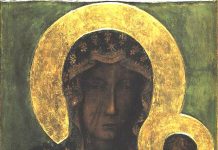Not many in the hierarchy write like Saint Peter Damian (+1072) anymore, whose direct and blunt condemnation of the unnatural sexual sins of the clergy he condemns in his vivid Book of Gomorrah, as told in summary form by Carl Sundell.
Then again, not many today in the hierarchy write like Pope Benedict XVI, who, in the midst of a series of Wednesday audiences on the Church fathers, sings the praises of the 11th century bishop and doctor, who was not by nature a fire-and-brimstone Cromwellian iconoclast, but rather a highly cultured man, immersed in the beauty and culture of his age, one of the finest of Latinists, who penned treatises, hymns, poems and sermons that still move the soul. His condemnation of sin – and his own practice of asceticism – was a propaedeutic to the appreciation of beauty, truth and goodness, to which vice, especially disordered lust, blinds us. Only thus can true joy – interior, spiritual joy transcending the vicissitudes of this world – be found.
That is why many have adopted Petrus Damianus as a patron of the synod on the ‘sex abuse crisis’ engulfing the Church. And as many others have written, unless said synod recognizes that sin – not procedural policies – is the root of this crisis, little good will be achieved. And by ‘sin’ we mean the ‘sin’ condemned by Damian, which we may hope is named by name, so the axe may be brought down upon the root of the withered and decayed tree, and good fruit borne again. (Editor)
BENEDICT XVI
GENERAL AUDIENCE
Paul VI Audience Hall
Wednesday, 9 September 2009
[Video]
Saint Peter Damian
Dear Brothers and Sisters,
During the Catecheses of these Wednesdays I am commenting on several important people in the life of the Church from her origins. Today I would like to reflect on one of the most significant figures of the 11th century, St Peter Damian, a monk, a lover of solitude and at the same time a fearless man of the Church, committed personally to the task of reform, initiated by the Popes of the time. He was born in Ravenna in 1007, into a noble family but in straitened circumstances. He was left an orphan and his childhood was not exempt from hardships and suffering, although his sister Roselinda tried to be a mother to him and his elder brother, Damian, adopted him as his son. For this very reason he was to be called Piero di Damiano, Pier Damiani [Peter of Damian, Peter Damian]. He was educated first at Faenza and then at Parma where, already at the age of 25, we find him involved in teaching. As well as a good grounding in the field of law, he acquired a refined expertise in the art of writing the ars scribendi and, thanks to his knowledge of the great Latin classics, became “one of the most accomplished Latinists of his time, one of the greatest writers of medieval Latin” (J. Leclercq, Pierre Damien, ermite et homme d’Église, Rome, 1960, p. 172).
He distinguished himself in the widest range of literary forms: from letters to sermons, from hagiographies to prayers, from poems to epigrams. His sensitivity to beauty led him to poetic contemplation of the world. Peter Damian conceived of the universe as a never-ending “parable” and a sequence of symbols on which to base the interpretation of inner life and divine and supra-natural reality. In this perspective, in about the year 1034, contemplation of the absolute of God impelled him gradually to detach himself from the world and from its transient realties and to withdraw to the Monastery of Fonte Avellana. It had been founded only a few decades earlier but was already celebrated for its austerity. For the monks’ edification he wrote the Life of the Founder, St Romuald of Ravenna, and at the same time strove to deepen their spirituality, expounding on his ideal of eremitic monasticism.
One detail should be immediately emphasized: the Hermitage at Fonte Avellana was dedicated to the Holy Cross and the Cross was the Christian mystery that was to fascinate Peter Damian more than all the others. “Those who do not love the Cross of Christ do not love Christ”, he said (Sermo XVIII, 11, p. 117); and he described himself as “Petrus crucis Christi servorum famulus Peter, servant of the servants of the Cross of Christ” (Ep, 9, 1). Peter Damian addressed the most beautiful prayers to the Cross in which he reveals a vision of this mystery which has cosmic dimensions for it embraces the entire history of salvation: “O Blessed Cross”, he exclaimed, “You are venerated, preached and honoured by the faith of the Patriarchs, the predictions of the Prophets, the senate that judges the Apostles, the victorious army of Martyrs and the throngs of all the Saints” (Sermo XLVII, 14, p. 304). Dear Brothers and Sisters, may the example of St Peter Damian spur us too always to look to the Cross as to the supreme act God’s love for humankind of God, who has given us salvation.
(To continue reading, please see here).











